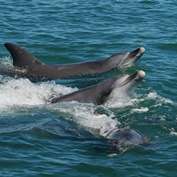Credit: Murdoch University
The world's first sex-based study with insights into the abundance and movement patterns of bottlenose dolphins acts as an impetus for future studies.
Dr Kate Sprogis, from Murdoch University Cetacean Research Unit (MUCRU), used data drawn from seven years of research by the South West Marine Research Program (SWMRP) on Indo-Pacific bottlenose dolphins off Bunbury to establish the abundance, movement patterns and survival for male and female dolphins, separately.
"It is difficult to tell the difference between male and female bottlenose dolphins in the wild as they look the same, in shape and appearance. This difficulty is why sex-based studies on abundance have been lacking" said Dr Sprogis.
"We are fortunate in Bunbury to have a long term study of the dolphin population where we have established the sex of several individuals through molecular analyses and by monitoring calving.
"This has given us sufficient data to study the abundance and movement patterns for males and females separately."
"We now know that the abundance for both males and females fluctuates seasonally within our 540 km2 study area, with greater numbers of both sexes in near-shore waters over the summer and autumn" Dr Sprogis said.
"Interestingly, over winter there were half as many males as there were females in the area, which confirms that males are ranging much further than females.
"Over Spring, we saw that both males and females had high return rates into the study area, which is most likely in preparation for the peak breeding season in Summer and Autumn.
"We also found that males and females have similar and high rates of survival in Bunbury."
Dr Sprogis said that this sort of specific knowledge about a coastal dolphin population is of fundamental importance in studies of wildlife biology. Sex-based patterns of abundance, movements and survival determine the reproductive success of the population, and are of interest to environmental managers.
A sex-based approach is of further importance as one sex may be impacted from threats more than the other sex, for example, from coastal development. This approach and knowledge is critical for wildlife populations or species of conservation concern.
The study was published in Frontiers in Marine Science and more about this research can be viewed here. This research forms part of Dr Sprogis's PhD research findings, which are summarised here.
More information: Kate R. Sprogis et al. Sex-Specific Patterns in Abundance, Temporary Emigration and Survival of Indo-Pacific Bottlenose Dolphins (Tursiops aduncus) in Coastal and Estuarine Waters, Frontiers in Marine Science (2016). DOI: 10.3389/fmars.2016.00012
Provided by Murdoch University
























